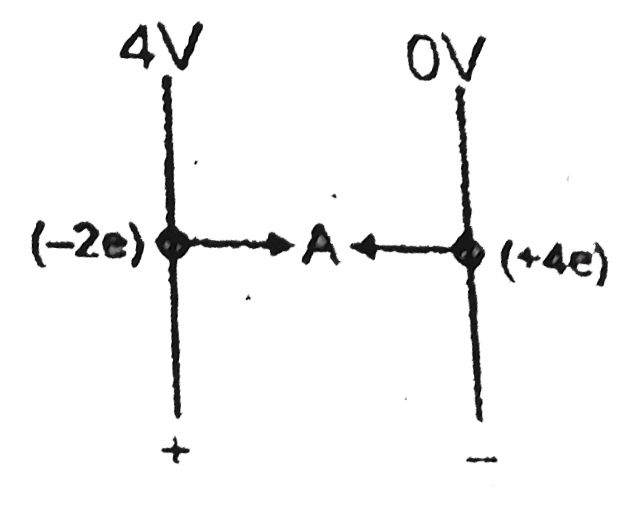In the assembly as shown below, the potential difference across the plates is 4 volts.A positive particle of charge +4e is projected from the negative plate with an initial kinetic energy of 4ev and the negative particle of charge (-2e) is projected from the positive plate.Both the particles reach point 'A' with zero kinetic energy.Find the initial kinetic energy of the negative particle in eV.

Text Solution
For the positive particle , applying energy conservation initially and at a point A
K.E.1+P.E.1=K.E.1+P.E.1
⇒4eV+(+4e)(0V)=0+(+4e)(xvolt) (x=potential at point A)
⇒x=1 volt
Now applying energy conservation for the negative particle at point 'A' and initially
⇒K.E.1+(−2e)(4V)=0+(−2e)(1volt)
K.E.1−8eV=−2eV
⇒K.E.1=6eV
|
Topper's Solved these Questions
Similar Questions
Knowledge Check
A particle is projected at 60∘ to the horizontal with kinetic energy K. Its kinetic energy at the highest point is :
AKBzeroCK4DK2A particle is projected at 60(∘) to the horizontal with a kinetic energy K . The kinetic energy at the highest point is
AKBzeroCK/4DK/2An alpha particle (charge= +2e) is accelerated from rest through a potential difference of 500 volts. Its final kinetic energy is
A50 eVB500 eVC1000eVD2000eV
A particle is projected at 60∘ to the horizontal with kinetic energy K. Its kinetic energy at the highest point is :
View SolutionA paricle is projected at an anged θ from the horizontal with kinetic energy (T). What is the kinetic energy of the particle at the highest point ?
View SolutionA particle is projected at an angle θ from the horizontal with kinetic energy (T). What is the kinetic energy of the particle at the highest point ?
View SolutionA body is projected such that its kinetic energy at the top is 3/4th of its initial kinetic energy. What is the initial angle of projection of the projectile with the horizontal ?
View SolutionAn alpha particle (charge= +2e) is accelerated from rest through a potential difference of 500 volts. Its final kinetic energy is
View Solution
